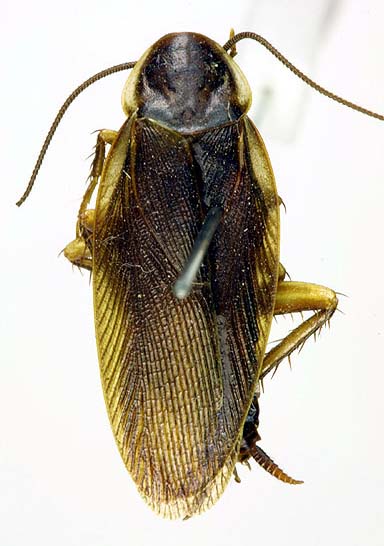경도바퀴
Asiablatta kyotensis (Asahina
1976)
몸길이는 약 14.5-18 ㎜이며 광택이 나는 다갈색이다. 앞가슴등판의 양측과 앞날개 전연부가 밝은 황색이다. 야외성으로 썩은 나무, 수액 등에 모인다. 연 1 회 발생한다. 일본에도 분포한다.

Original description: Parcoblatta kyotensis Asahina 1976
♂ Body
length 14.5-18.0 ㎜, forewing length 13-15.5 ㎜, width of prothoracic
tergite ca. 4 ㎜. A dark brownish species, body surface not shining.
Head
brownish with whitish antennal socket and ocular spot; face seen
from front elongate, the anteclypeus being paler. Eyes fairly approaching
each other; antenna nearly as long as the body length, entirely
blackish brown. The maxillary palpus with its third and fifth segments
of equal length, longer than that of the fourth.
Prothoracic
tergite rather thin and flat, sparcely pubescent but never shining,
entirely dull brownish excepting the lateral free sides which are
somewhat deflected and paler in colour.
The anteroventral
setae of forefemur is so-called B-type, 3-4 proximal strong spines
are followed by about 11-12 minute setae, and ending in three terminal
strong spines.
The euplantula is on 1-4 tarsal segments,
but not much developed. There is an arolium on the last tarsal segment
between the claws. The first tarsal segment of hindleg is longer
than the 1-4 tarsal segments put together.
Forewing
deep chestnut brown with minutely wrinkled surface; the costal area
before Sc pale yellow, making a distinct pale stripe as that of
Periplaneta australasiae.
Hindwing almost hyaline, distal half of the anterior field palely
browned; vein M simple, 3-4 branches of Cu attaining the wing margin,
while 3-4 short branches ending before the dividing vein.
Dorsal
surface of abdomen simple, pale brownish; surface of each segment
devoid of any structure. Supraanal plate also simple, ending in
a bisor, but it is shorter than the subgenital plate, the latter
seems as if it is an entire symmetrical plate though slightly developed
in its left half; the left stylus, therefore, is attached on a slightly
produced base. The stylus is a simple stick and bending ventrad.
The left phallosome has a claw as shown in Fig. 18.
♀
Closely allied in general feature to the male insect, but slightly
broader in the body, and the wings are shorter reaching the end
of the body, exceeding it while immature.
Head as
that of the male, the antenna being distinctly shorter than the
body length; prothoracic tergite broader than that of the male,
its lateral broader is not deflected as that of the male, but there
is a lateral short pale stria. The wings are never shortened as
those of many American species.
Forewing shorter
than that of the male, the pale yellowish area before Sc is not
always present. Hindwing also short, but the venation is similar
to that of the male.
Dorsal side of abdomen simple
and smooth, the eighth tergite with its lateral part produced into
a small tube having the orifice of the stigma at its end. Supraanal
plate produced into a triangular plate with marginal row of setae.
Subgenital plate large and roundly produced.
Remarks:
Compared with American congeners the male of kyotensis
is allied to that of bolliana
(S.&Z.) and desertae (R.&H.)
in the absence of abdominal tergal specialization, but the female
of kyotensis
has long wings against the brachypterous females of the two American
species. In her well developed wings the female of kyotensis
is a allied to caudelli
Hebard but differs in that of the male of caudelli
has markedly specialized abdominal tergites.
Holotype
♂ and allotype ♀ and 7♂14♀ paratypes: Kyoto (Okazaki Zoo specimens);
Paratypes: 1♂ Fukuoka, leg. T. Esaki; 1♂ Ogi, Ishikawa Prefecture,
leg. H. Sasaji.
The type-specimens are preserved
in Coll. Asahina.
The American species of Parcoblatta
have been known to occur under natural habitats, beneath barks or
rotten woods. The present Japanese species is believed to be a wild
insect even if it was found in human dwellings.
|
유충 |
1월 |
2월 |
3월 |
4월 |
5월 |
6월 |
7월 |
8월 |
9월 |
10월 |
11월 |
12월 |
|
성충 |
1월 |
2월 |
3월 |
4월 |
5월 |
6월 |
7월 |
8월 |
9월 |
10월 |
11월 |
12월 |
<참고문헌>